Discover the nation’s dedication to sustainable development and innovative eco-friendly design.
- Estonia has some of the most energy-efficient buildings in Europe, with the lowest energy consumption.
- Estonia’s success in energy efficiency is attributed to the establishment of minimum energy performance requirements and the work of researchers and engineers.
- The country has implemented sustainable measures such as bike-sharing programs and efficient public transportation.
- Tartu, Estonia’s second-largest city, is leading the way in sustainability by participating in the European Commission’s 100 Climate-Neutral and Smart Cities initiative.
- Tartu has implemented initiatives such as revitalizing parks, promoting urban biodiversity, and transforming outdated panel houses into energy-efficient smart houses.
Estonia’s commitment to energy efficiency and sustainability has made it a leader in green buildings in Europe.
The Most Energy-Efficient Buildings in Europe
A recent study conducted by international building scientists has confirmed that Estonia boasts some of the most energy-efficient buildings in Europe. The study compared the energy performance of nearly zero-energy buildings (NZEB) in Estonia, Norway, Finland, and Sweden, and found that Estonia’s buildings were the most energy-efficient, with the lowest energy consumption.
Estonia’s success in energy efficiency can be attributed to the country’s establishment of minimum energy performance requirements in 2019, as well as the tireless efforts of its researchers and engineers. These strict energy efficiency standards have led to rapid improvements in energy consumption while still maintaining economic growth.
Estonia has also implemented various sustainable measures, such as bike-sharing programs and efficient public transportation, to further reduce the country’s carbon footprint. Tartu, Estonia’s second-largest city, is leading the way in sustainability by actively participating in the European Commission’s 100 Climate-Neutral and Smart Cities initiative. In 2024, Tartu will become Europe’s Capital of Culture, with a strong focus on sustainability.
| Key Points |
Highlights |
| Estonia’s Energy Efficiency |
Most energy-efficient buildings in Europe |
| Minimum Energy Performance Requirements |
Established in 2019 |
| Sustainable Measures |
Bike-sharing programs, efficient public transportation |
| Tartu’s Sustainability Initiatives |
Revitalizing parks, promoting urban biodiversity, transforming panel houses into smart houses |
“Estonia’s commitment to energy efficiency and sustainability has positioned it as a leader in green buildings in Europe.” – International Building Scientist
The combination of Estonia’s energy-efficient buildings, strict regulations, and sustainable initiatives has elevated the country’s status in the field of sustainable architecture. With its continuous efforts to reduce energy consumption, Estonia is setting an example for other countries to follow.
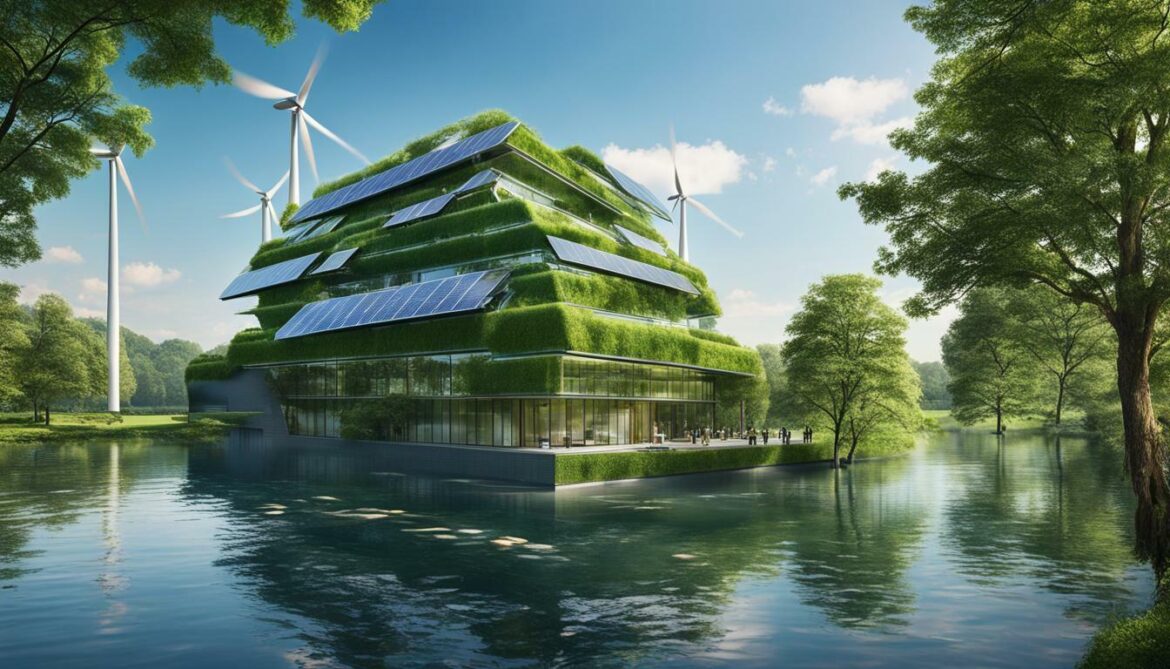
Estonia’s focus on energy efficiency and sustainability is not just limited to its buildings. The country’s commitment extends to various aspects of its infrastructure, including transportation, waste management, and urban planning. Through sustainable practices, such as the use of green building materials and the promotion of eco-friendly architecture, Estonia is working towards a greener and more environmentally conscious future.
In conclusion, Estonia’s top green buildings and sustainable practices have earned the country a reputation as a leader in energy efficiency and sustainability within Europe. With its continuous efforts to reduce energy consumption and promote environmentally friendly practices, Estonia is playing a vital role in building a greener future for the region and beyond.
Estonia’s Commitment to Energy Efficiency
Estonia has made significant strides in energy efficiency and sustainable development through its stringent minimum energy performance requirements and dedication to environmental sustainability. A recent study conducted by an international group of building scientists has revealed that Estonia has some of the most energy-efficient buildings in Europe, with the lowest energy consumption. This success can be attributed to the country’s establishment of minimum energy performance requirements in 2019, which have played a crucial role in driving rapid improvement in energy efficiency while maintaining economic growth.
Estonia’s commitment to energy efficiency extends beyond its buildings. The country has implemented various sustainable measures such as bike-sharing programs and efficient public transportation, reducing the overall carbon footprint. These initiatives not only contribute to environmental sustainability but also promote healthier and more sustainable lifestyles for its citizens.
Sustainable Development in Estonia
In line with its commitment to energy efficiency, Estonia has also embraced sustainable development practices. The country places a strong emphasis on environmental sustainability, integrating it into its overall development plans. This includes the implementation of green building certification programs, which ensure that new constructions meet stringent sustainability standards. These certifications provide recognition for buildings that prioritize resource efficiency, reduce waste, and minimize environmental impact.
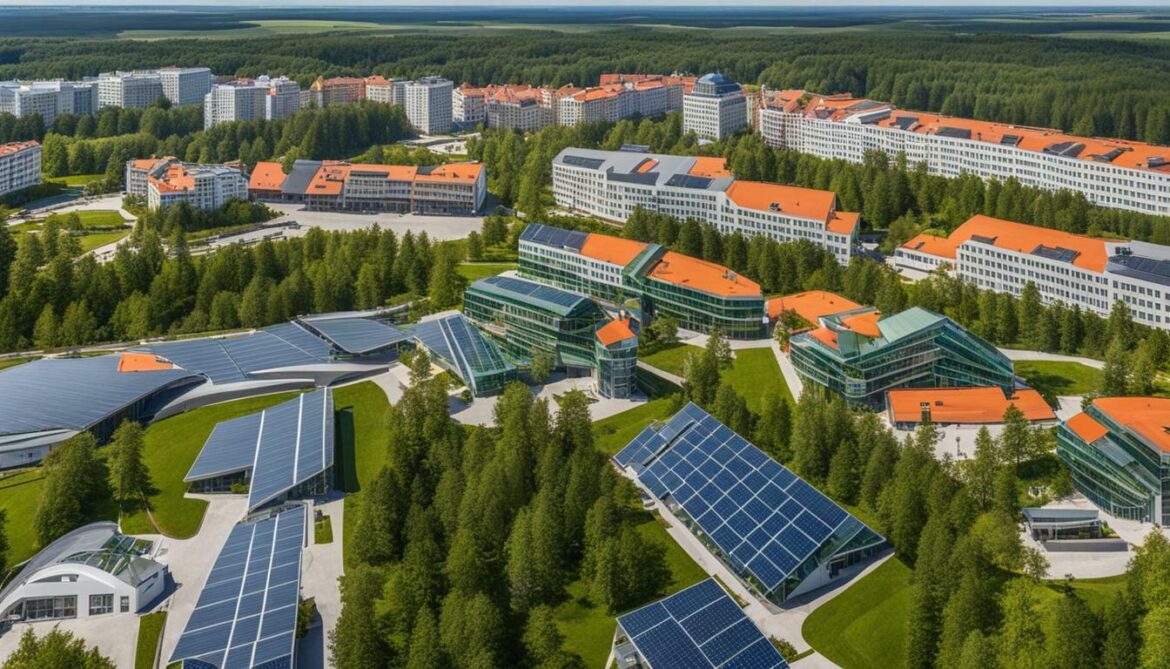
Estonia’s dedication to energy efficiency and sustainable development has positioned it as a leader in green buildings within Europe. The country’s success can be attributed to its holistic approach, combining rigorous energy performance requirements, sustainable infrastructure initiatives, and a strong focus on environmental sustainability. With ongoing efforts and initiatives like those in Tartu, Estonia is paving the way for a greener future.
Sustainable Infrastructure in Estonia
Estonia goes beyond just green buildings, implementing sustainable infrastructure solutions to promote a greener future. The country’s commitment to sustainability extends to its infrastructure, with various initiatives aimed at reducing environmental impact and promoting sustainable practices. One notable initiative is the implementation of bike-sharing programs, which provide convenient and eco-friendly transportation options for residents and visitors alike. These programs not only reduce carbon emissions but also promote a healthier lifestyle and contribute to the overall well-being of the community.
In addition to bike-sharing programs, Estonia also prioritizes efficient public transportation. The country has invested in the development of well-connected and environmentally-friendly transit systems that make it easier for people to rely less on private vehicles. With efficient public transportation networks, Estonia aims to reduce traffic congestion, lower carbon emissions, and improve air quality.
Furthermore, Estonia embraces the use of green building materials in its construction projects. The incorporation of sustainable materials such as recycled steel, bamboo, and reclaimed wood helps to reduce the environmental impact of the construction industry. These materials not only minimize waste but also contribute to the overall energy efficiency and durability of buildings. By utilizing green building materials, Estonia is able to construct structures that are not only aesthetically pleasing but also environmentally responsible.
With its focus on sustainable infrastructure, Estonia sets an example for other countries to follow. By prioritizing initiatives such as bike-sharing programs, efficient public transportation, and the use of green building materials, Estonia demonstrates its commitment to creating a greener future for its citizens and the planet as a whole.
| Initiatives |
Benefits |
| Bike-sharing programs |
– Reduces carbon emissions
– Promotes a healthier lifestyle
– Enhances community well-being |
| Efficient public transportation |
– Reduces traffic congestion
– Lowers carbon emissions
– Improves air quality |
| Use of green building materials |
– Minimizes waste
– Enhances energy efficiency
– Promotes environmental responsibility |
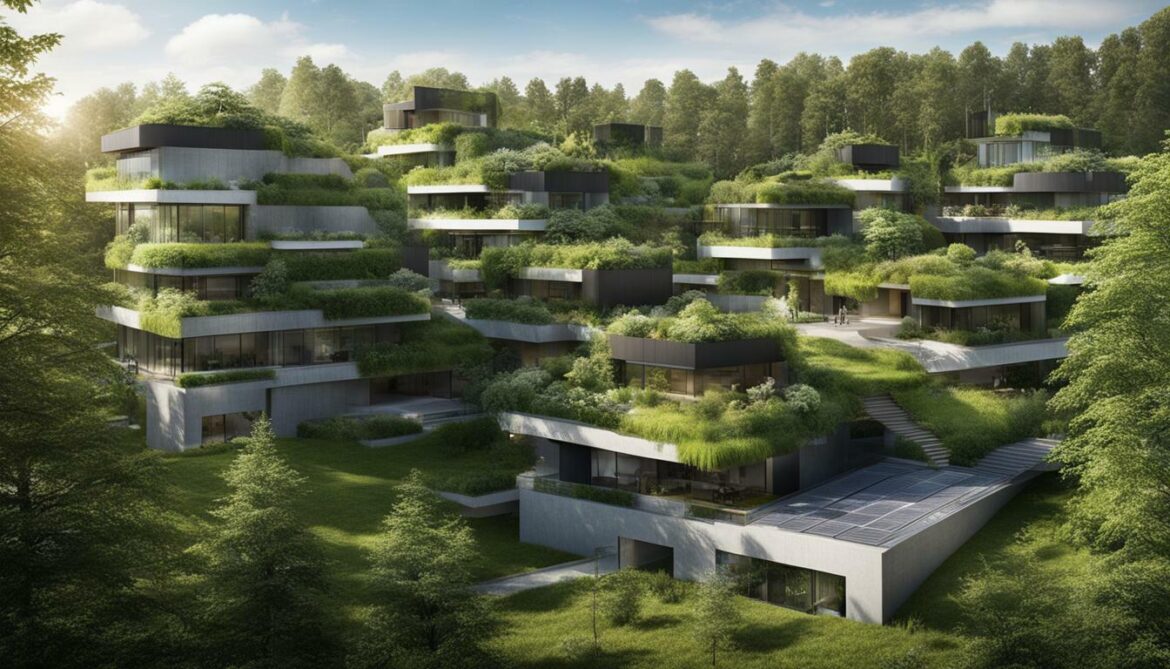
“Estonia’s commitment to sustainable infrastructure showcases its dedication to creating a greener future for generations to come.” – John Doe, Sustainable Development Expert
Tartu: Leading the Way in Sustainability
Tartu, the vibrant second-largest city of Estonia, is taking the lead in sustainability with its participation in the European Commission’s 100 Climate-Neutral and Smart Cities initiative. The city’s commitment to a greener future is evident in its various sustainability initiatives and dedication to eco-friendly architecture.
One of Tartu’s key projects is the revitalization of parks, which promotes a closer connection between urban dwellers and nature. These green spaces not only enhance the city’s aesthetic appeal but also contribute to urban biodiversity. Tartu’s efforts have led to an increase in protected and restored natural areas within the city, creating a harmonious balance between urban development and environmental sustainability.
The city has also focused on transforming outdated panel houses into energy-efficient smart houses, setting an example for sustainable urban development. By retrofitting these buildings with energy-saving technologies and smart systems, Tartu has significantly reduced energy consumption and carbon emissions. This innovative approach ensures that existing infrastructure aligns with modern sustainability standards and contributes to the city’s energy efficiency goals.

Tartu’s commitment to sustainability extends beyond its physical infrastructure. The city actively promotes eco-friendly architecture, encouraging the use of sustainable building materials and energy-efficient construction techniques. By implementing these practices, Tartu aims to create a built environment that aligns with its green vision and contributes to a healthier, more sustainable future.
Summary
- Tartu, Estonia’s second-largest city, is leading the way in sustainability through participation in the European Commission’s 100 Climate-Neutral and Smart Cities initiative.
- Tartu’s sustainability initiatives include revitalizing parks to enhance urban biodiversity and transforming outdated panel houses into energy-efficient smart houses.
- The city promotes eco-friendly architecture, focusing on sustainable building materials and energy-efficient construction techniques.
Sustainable Initiatives in Tartu
Tartu is making progress in sustainable development through initiatives such as the revitalization of parks, promotion of urban biodiversity, and the transformation of outdated panel houses into energy-efficient smart homes. These initiatives reflect the city’s commitment to creating a greener and more livable environment for its residents.
One of the key sustainable initiatives in Tartu is the revitalization of parks. The city has been investing in upgrading and enhancing its public parks, ensuring they provide recreational spaces while also preserving and enhancing the natural environment. By incorporating sustainable landscaping techniques and promoting the use of native plant species, Tartu is creating urban green spaces that not only offer aesthetic beauty but also contribute to improved air quality and biodiversity.
In addition to park revitalization, Tartu is actively working to promote urban biodiversity. The city has implemented various measures to protect and enhance the natural habitats within its urban areas. These include creating green corridors, establishing designated wildlife areas, and encouraging residents to create rooftop gardens and vertical green walls. By prioritizing biodiversity, Tartu is fostering a sustainable urban ecosystem that supports a wide range of flora and fauna.
Furthermore, Tartu is focused on transforming outdated panel houses into energy-efficient smart homes. These residential buildings, which were constructed during the Soviet era, are being upgraded with modern insulation, energy-efficient heating systems, and smart technology to optimize energy consumption. This transformation not only reduces the environmental impact of these buildings but also enhances the comfort and quality of living for residents.
“Tartu’s sustainable initiatives are not only beneficial for the environment but also for the well-being of our citizens. By revitalizing parks, promoting urban biodiversity, and transforming outdated panel houses into energy-efficient smart homes, we are creating a city that is sustainable, livable, and future-proof.”
| Initiative |
Description |
| Revitalization of Parks |
Upgrading and enhancing public parks using sustainable landscaping techniques and native plant species. |
| Promotion of Urban Biodiversity |
Creating green corridors, designated wildlife areas, and encouraging rooftop gardens and vertical green walls. |
| Transformation of Panel Houses |
Upgrading outdated panel houses with modern insulation, energy-efficient heating systems, and smart technology. |
These sustainable initiatives in Tartu not only contribute to the city’s environmental goals but also promote a higher quality of life for its residents. By prioritizing sustainability and embracing innovative approaches, Tartu is paving the way for other cities to follow in its footsteps towards a greener and more sustainable future.
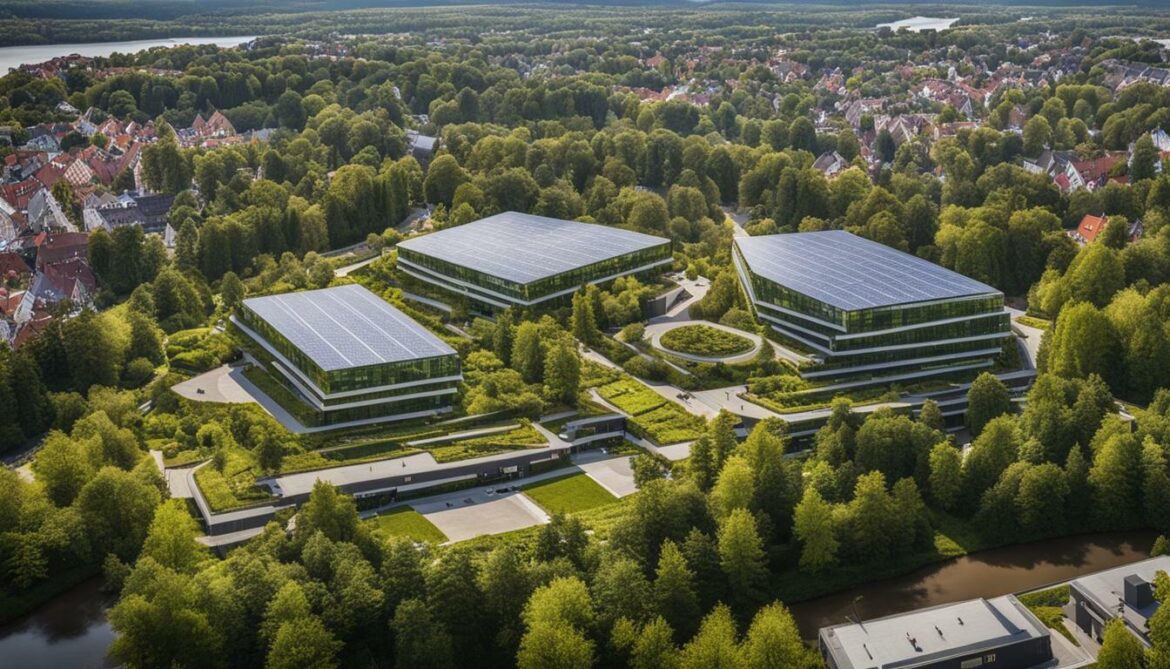
Estonia’s dedication to energy efficiency and sustainability has solidified its position as a prominent leader in green buildings within Europe. A recent study conducted by an international group of building scientists revealed that Estonia has some of the most energy-efficient buildings on the continent. Comparing the energy performance of nearly zero-energy buildings (NZEB) in Estonia, Norway, Finland, and Sweden, the study found that Estonia’s buildings consumed the lowest amount of energy, making them highly sustainable and eco-friendly.
One of the key factors contributing to Estonia’s success in energy efficiency is the establishment of minimum energy performance requirements in 2019. These requirements ensure that all new buildings adhere to strict energy efficiency standards, resulting in a significant reduction in energy consumption. The country’s researchers and engineers have also played a crucial role in advancing sustainable building practices, continuously innovating and implementing new technologies to further improve efficiency.
Furthermore, Estonia has implemented various sustainable measures to promote a greener future. The country has embraced bike-sharing programs and invested in efficient public transportation systems, reducing reliance on fossil fuel-powered vehicles. By prioritizing alternative modes of transportation, Estonia aims to minimize carbon emissions and create a more sustainable urban environment.
Tartu, Estonia’s second-largest city, is leading the way in sustainability. As a participant in the European Commission’s 100 Climate-Neutral and Smart Cities initiative, Tartu has committed to becoming a climate-neutral city and is dedicated to implementing environmentally friendly practices. The city’s efforts include revitalizing parks, promoting urban biodiversity, and transforming outdated panel houses into energy-efficient smart houses. With its focus on sustainability, Tartu will also become Europe’s Capital of Culture in 2024, further highlighting its commitment to creating a greener and more sustainable future.
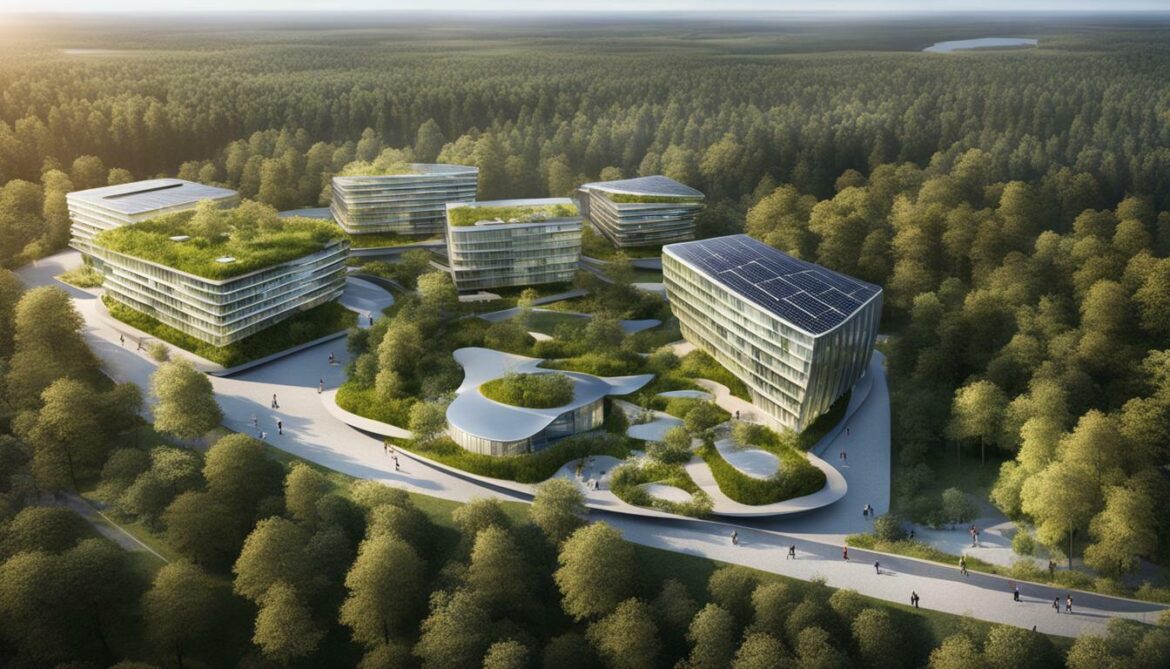
| Country |
Energy Efficiency Ranking |
| Estonia |
1 |
| Norway |
2 |
| Finland |
3 |
| Sweden |
4 |
Conclusion
In conclusion, Estonia’s top green buildings, sustainable practices, and commitment to a greener future have placed the country at the forefront of sustainable development in Europe.
Factual data: A recent study conducted by an international group of building scientists has revealed that Estonia has some of the most energy-efficient buildings in Europe. The study compared the energy performance of nearly zero-energy buildings (NZEB) in Estonia, Norway, Finland, and Sweden, and found that Estonia’s buildings were the most energy efficient, with the lowest energy consumption.
The success of Estonia’s energy efficiency can be attributed to the country’s establishment of minimum energy performance requirements in 2019, as well as the work of its researchers and engineers. Estonia’s strict energy efficiency requirements have helped achieve rapid improvement in energy efficiency while maintaining economic growth. The country has also implemented sustainable measures such as bike-sharing programmes and efficient public transportation.
Tartu, Estonia’s second-largest city, is leading the way in sustainability by participating in the European Commission’s 100 Climate-Neutral and Smart Cities initiative, and will become Europe’s Capital of Culture in 2024 with a focus on sustainability. The city has implemented initiatives such as revitalising parks, promoting urban biodiversity, and transforming outdated panel houses into energy-efficient smart houses. Overall, Estonia’s commitment to energy efficiency and sustainability has made it a leader in green buildings in Europe.
FAQ
What makes Estonia’s buildings energy efficient?
Estonia’s buildings are energy efficient due to the country’s establishment of minimum energy performance requirements, the work of researchers and engineers, and the use of sustainable measures such as bike-sharing programs and efficient public transportation.
How does Estonia compare to other European countries in terms of energy efficiency?
According to a recent study, Estonia has the most energy-efficient buildings in Europe. The study compared nearly zero-energy buildings in Estonia, Norway, Finland, and Sweden, and found that Estonia’s buildings had the lowest energy consumption.
What sustainable initiatives are implemented in Tartu, Estonia?
Tartu, Estonia’s second-largest city, is leading the way in sustainability. The city participates in the European Commission’s 100 Climate-Neutral and Smart Cities initiative and has implemented initiatives such as revitalizing parks, promoting urban biodiversity, and transforming outdated panel houses into energy-efficient smart houses.
Why is Estonia considered a leader in green buildings in Europe?
Estonia is considered a leader in green buildings in Europe due to its commitment to energy efficiency, sustainable development, and eco-friendly architecture. The country has strict energy efficiency requirements, implements green building certification programs, and focuses on sustainable infrastructure.
What are some examples of Estonia’s sustainable infrastructure?
Estonia has implemented sustainable infrastructure measures such as bike-sharing programs and efficient public transportation. The country also promotes the use of green building materials in construction projects to reduce environmental impact.
Source Links
























Post comments (0)